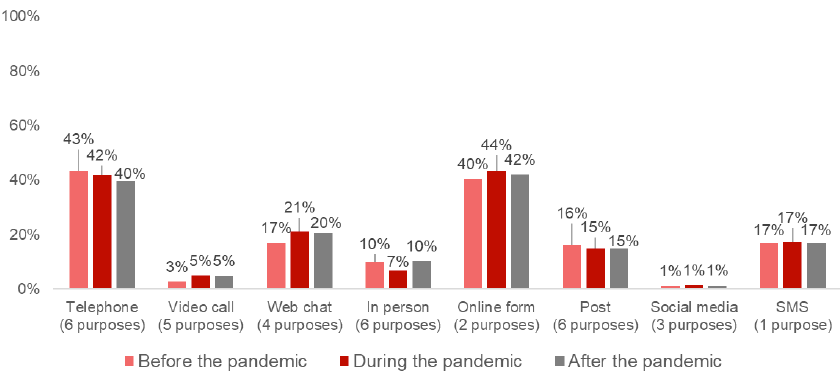Social Security client and experience panels research: effects of the coronavirus pandemic on communication preferences
A report of findings from research with client and experience panels about communication preferences.
This document is part of a collection
Getting in touch with Social Security Scotland before, during and the after the pandemic
Both survey respondents and interview participants were asked how they preferred to get in touch and why, and if this changed for different purposes. All were also asked if their preferences would be different during or after the pandemic. This chapter provides an overview of responses from survey respondents.
Most respondents said they preferred a mix of communication methods for getting in touch for different reasons. Only a small number said they would use the same method to get in touch regardless of the purpose. There was little change in preferences before, during and after the pandemic.
Getting in touch for different reasons
Table 4 shows the preferred method for getting in touch for six different purposes. The table also shows the proportion of respondents choosing that method before, during and after the pandemic. Figures for all methods for each purpose can be found in Tables C1 to C6 in Annex C.
| Reason for getting in touch | Most preferred method | Before the pandemic | During the pandemic | After the pandemic |
|---|---|---|---|---|
| Advice and general information | Telephone | 50% | 47% | 45% |
| Applying for a benefit | Online form | 44% | 49% | 47% |
| Monitoring the progress of your application | Telephone | 51% | 47% | 46% |
| Challenge a decision | Paper form/post | 48% | 47% | 47% |
| An urgent situation relating to your application | Telephone | 69% | 65% | 63% |
| Advising a change in circumstances | Telephone 39% | Online form 38% | Online form 37% |
Telephone came in first place for three out of the six purposes: for advice and general information; monitoring the progress of an application; and for urgent situations. For these purposes, telephone remained the most preferred method before, during and after the pandemic. There was only a small decline after the pandemic compared to before.
Around half of respondents said their preferred way to make an application was an online form. This remained the case before, during and after the pandemic.
Respondents could choose between three methods to challenge a decision made about an application: paper form, telephone and in person. Before, during and after the pandemic, around half said they would do this via a paper form.
Advising a change in circumstances was the only purpose for which the preferred method changed during and after the pandemic. Before the pandemic, just more than a third (39 per cent) of respondents said telephone was their preferred way to do this. During and after the pandemic, online form narrowly overtook telephone with around a third preferring this.
Methods of communication
Respondents were able to choose between options which were relevant to each purpose for getting in touch. This means not all methods were available to choose for each purpose. Figure 4 shows survey respondents' preferred communication methods before, during and after the pandemic.[4]
Figure 4: Survey respondents' preferred communication methods before, during and after the pandemic. Total choices for each method across available purposes. (n= approx. 484)

Respondents could chose telephone, in person and post (paper forms or letters) for all of the purposes. Around 40 per cent of respondents said telephone was their preferred choice before, during and after the pandemic. Around one in ten (10 per cent) of respondents said meeting in person would be their preferred across all purposes. Preference for post across all the purposes remained roughly the same before, during and after the pandemic at around 15 per cent of respondents.
Around 40 per cent of respondents chose online form for making an application and advising a change in circumstances. The proportion of respondents choosing web chat increased during and after the pandemic to around a fifth (20 per cent). Respondents could select text messages (SMS) for updates about the progress of an application. Less than a quarter (17 per cent) said this would be their preferred method before, during and after the pandemic.
Video call was included as an option for all purposes except to challenge a decision. Around 5 per cent of respondents said video call would be their preferred method after the pandemic. Only around 1 per cent of respondents indicated a preference for social media for advice and information, progress updates or urgent situations.
Contact
There is a problem
Thanks for your feedback